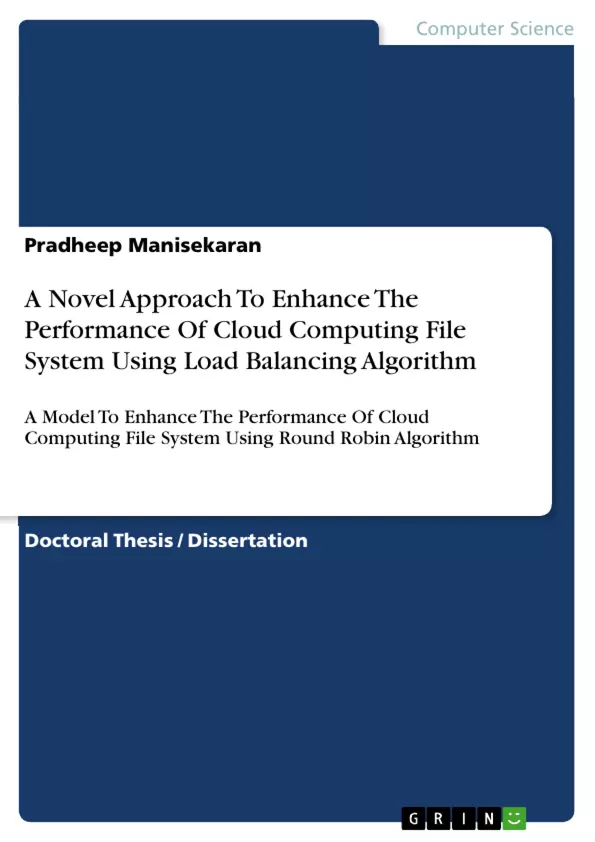Cloud computing is one of the biggest thing in computing in recent time. Cloud computing uses the internet and the central remote servers to support different data and applications. Cloud computing is that emerging technology which is used for providing various computing and storage services over the Internet. In the cloud computing, the internet is viewed as a cloud. Internet users can receive services from a cloud as if they were employing a super computer which be using cloud computing. To storing data in the cloud instead of on their own devices and it making ubiquitous data access possible. Load balancing helps to make resource utilization effective and also used to improve the response time of the job. The load balancing helps to remove the nodes which are unbalanced. In this situation, it removes the nodes, which are overloaded or under loaded. It is dynamic in nature. In the cloud computing, file system management is the big issue. We use round robin algorithm with load balancing in the file systems. It will help to enhance the performance of file system. It also helps to increase the access of file systems in cloud computing.
Inhaltsverzeichnis (Table of Contents)
- CHAPTER 1 INTRODUCTION
- 1.1 Major Trends In Cloud Computing
- 1.2 Key Features Of Cloud Computing
- 1.3 The Essential Characteristics of Cloud Computing
- 1.4 Components Of Cloud Computing
- 1.5 Virtualization
- 1.6 Features of cloud computing
- 1.7 Cloud Computing Architecture
- 1.8 Cloud Computing Applications
- 1.9 Load Balancing
- 1.10 Goals of Load balancing
- 1.11 Types of Load balancing algorithms
- 1.12 File System in cloud computing
- 1.13 Round Robin Algorithm
- CHAPTER 2 - LITERATURE SURVEY
- CHAPTER 3 - PRESENT WORK
- 3. Present Work
- 3.1 Problem Formulation
- 3.2 Objectives
- 3.3 Methodology
- 3.4 Algorithm
- CHAPTER 4 - RESULT AND DISCUSSIONS
Zielsetzung und Themenschwerpunkte (Objectives and Key Themes)
This work aims to provide a comprehensive overview of cloud computing, exploring its major trends, key features, and essential characteristics. It delves into the components of cloud computing, including virtualization, cloud architecture, and applications. The text also examines the critical aspects of load balancing and file systems within cloud computing, analyzing different algorithms and their functionalities.
- Major Trends in Cloud Computing: Hybrid Clouds, BYOD, Platform-as-a-Service (PaaS), Web-powered apps, Big data analytics, Graphics as a service, Identity management and protection.
- Key Features of Cloud Computing: Resource pooling, Self-service and on-demand services, Pricing models, Quality of service.
- Cloud Computing Architecture and Applications: Exploring various aspects of cloud architecture, including virtualization, load balancing, and file systems.
- Problem Formulation and Objectives: Defining the specific problem addressed by the research and outlining the research objectives.
- Methodology and Algorithms: Discussing the research methodology employed and analyzing the algorithms used in the presented work.
Zusammenfassung der Kapitel (Chapter Summaries)
Chapter 1, "Introduction," provides an overview of cloud computing, its rise to prominence, and its significance in modern technology. It discusses the fundamental concepts of cloud computing, including the internet's role, its key features, and the components that constitute a cloud system. This chapter also delves into the major trends shaping the field, such as hybrid clouds, BYOD, and Platform-as-a-Service (PaaS). It further examines the essential features of cloud computing, including resource pooling, self-service models, pricing strategies, and quality of service.
Chapter 2, "Literature Survey," presents a comprehensive review of existing research and literature related to cloud computing. This chapter analyzes previous studies, theories, and frameworks relevant to the subject matter, providing a foundation for the research presented in the subsequent chapters.
Chapter 3, "Present Work," delves into the research conducted for this work. It outlines the specific problem addressed, the research objectives, and the methodology employed to investigate the problem. This chapter also presents the algorithm developed or utilized in the research, providing a detailed explanation of its design and implementation.
Chapter 4, "Result and Discussions," presents the findings and analysis of the research conducted. It discusses the results obtained through the application of the methodology and algorithm, providing a thorough interpretation and discussion of the significance of the findings. This chapter may include visual representations of data, tables, and graphs to illustrate and support the analysis.
Schlüsselwörter (Keywords)
The main keywords and focus topics of this text include cloud computing, virtualization, load balancing, file systems, hybrid clouds, BYOD, Platform-as-a-Service (PaaS), web-powered apps, big data analytics, graphics as a service, identity management, security, resource pooling, self-service models, pricing, quality of service, and algorithm analysis.
- Citar trabajo
- Pradheep Manisekaran (Autor), 2014, A Novel Approach To Enhance The Performance Of Cloud Computing File System Using Load Balancing Algorithm, Múnich, GRIN Verlag, https://www.grin.com/document/288801



